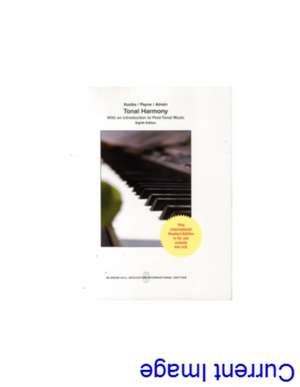Tonal Harmony
Autor Stefan Kostkaen Limba Engleză Paperback – 6 aug 2017
Preț: 430.97 lei
Preț vechi: 468.45 lei
-8% Nou
Puncte Express: 646
Preț estimativ în valută:
82.48€ • 86.76$ • 68.82£
82.48€ • 86.76$ • 68.82£
Carte disponibilă
Livrare economică 19 decembrie 24 - 02 ianuarie 25
Livrare express 05-11 decembrie pentru 52.03 lei
Preluare comenzi: 021 569.72.76
Specificații
ISBN-13: 9781259253560
ISBN-10: 1259253562
Dimensiuni: 203 x 252 x 23 mm
Greutate: 1.05 kg
Ediția:8
Editura: McGraw Hill Education
Colecția McGraw-Hill
Locul publicării:United States
ISBN-10: 1259253562
Dimensiuni: 203 x 252 x 23 mm
Greutate: 1.05 kg
Ediția:8
Editura: McGraw Hill Education
Colecția McGraw-Hill
Locul publicării:United States
Cuprins
Part I: Fundamentals
Chapter 1: Elements of Pitch
The Keyboard and Octave Registers
Notation of the Staff
The Major Scale
The Major Key Signatures
Minor Scale
Minor Key Signatures
Scale Degree Names
Intervals
Perfect, Major, and Minor Intervals
Augmented and Diminished Intervals
Inversion of Intervals
Consonant and Dissonant Intervals
Summary
Variations
Chapter 2: Elements of Rhythm
Rhythm
Durational Symbols
Beat and Tempo
Meter
Division of the Beat
Simple Time Signatures
Compound Time Signatures
Time Signatures Summarized
More on Durational Symbols
Summary
Variations
Chapter 3: Introduction to Triads and Seventh Chords
Introduction
Triads
Seventh Chords
Inversions of Chords
Inversion Symbols and Figured Bass
Lead Sheet Symbols
Recognizing Chords in Various Textures
Summary
Chapter 4: Diatonic Chords in Major and Minor Keys
Introduction
Diatonic Triads in Major
The Minor Scale
Diatonic Triads in Minor
Diatonic Seventh Chords in Major
Diatonic Seventh Chords in Minor
Summary
Part II: Diatonic Triads
Chapter 5: Principles of Voice Leading
Introduction
The Melodic Line
Notating Chords
Voicing a Singe Triad
Parallel Motion
Summary
Chapter 6: Root Position Part Writing
Introduction
Root Position Part Writing with Repeated Roots
Root Position Part Writing with Roots a 4th (5th) Apart
Root Position Part Writing with Roots a 3rd (6th) Apart
Root Position Part Writing with Roots a 2nd (7th) Apart
Instrumental Ranges and Transpositions
Summary
Chapter 7: Harmonic Progression
Introduction
Sequences and the Circle of Fifths
The I and V Chords
The II Chord
The VI Chord
The III Chord
The VII Chord
The IV Chord
Common Exceptions
Differences in the Minor Mode
Progressions Involving Seventh Chords
More About Harmonic Sequences
Harmonizing a Simple Melody
Conclusion
Summary
Chapter 8: Triads in First Inversion
Introduction
Bass Arpeggiation
Substituted First Inversion Triads
Inversions in Lead Sheets
Parallel Sixth Chords
Part Writing First Inversion Triads
Soprano-Bass Counterpoint
Summary
Chapter 9: Triads in Second Inversion
Introduction
Bass Arpeggiation and the Melodic Bass
The Cadential Six-Four
The Passing Six-Four
The Pedal Six-Four
Part Writing for Second Inversion Triads
Summary
Chapter 10: Cadences, Phrases, Periods, and Sentences
Musical Form
Cadences
Cadences and Harmonic Rhythm
Motives and Phrases
Mozart: “An die Freude”
Period Forms
The Sentence
Summary
Chapter 11: Two-Part Tonal Counterpoint
Introduction
Composing an Unembellished Bass Line
Composing a Counterpoint to the Bass Line
Composing the Contrapuntal Voice
Writing Your Own Harmonic Progressions
Summary
Chapter 12: Non-Chord Tones 1
Introduction
Classification of Non-Chord Tones
Passing Tones
Contrapuntal Considerations
Embellished Cadences
Embellishing versus Composing
Neighboring Tones
Suspensions and Retardations
Embellishing a Simple Texture
Figured Bass and Lead Sheet Symbols
Summary
